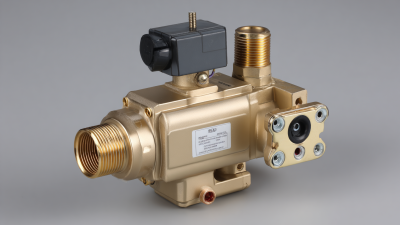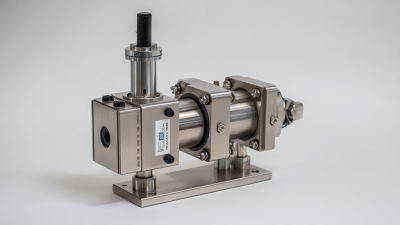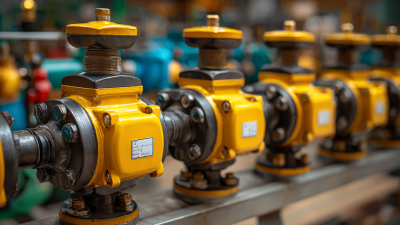7 Effective Strategies for Choosing the Right Electric Valve
Choosing the right electric valve is crucial for ensuring the efficiency and reliability of your fluid control systems. With a wide array of options available on the market, it can be challenging to identify which electric valve best suits your specific needs. From understanding the types of electric valves to recognizing the importance of flow characteristics, the selection process requires careful consideration. This blog will unveil seven effective strategies that will guide you in making an informed decision when selecting an electric valve. Whether you are a seasoned engineer or a newcomer to the industry, these tips will equip you with the knowledge necessary to optimize your system's performance and longevity. Dive in as we explore the key factors that distinguish one electric valve from another, helping you to make the best choice for your application.

Key Considerations for Electric Valve Selection Based on Industry Standards
When selecting electric valves, it's crucial to align your choice with industry standards and specific application requirements. According to a recent report by the International Society of Automation (ISA), nearly 25% of valve failures can be attributed to improper selection based on operational parameters. This highlights the importance of understanding factors such as pressure ratings and temperature limits, which must conform to the relevant industry standards, including API, ANSI, and ISO certifications. By ensuring compliance with these standards, you can significantly enhance system reliability and performance.
Additionally, the choice of materials used in electric valves can have a profound impact on their longevity and functionality. A study published in the Valve Manufacturers Association (VMA) indicated that using corrosion-resistant materials can increase the lifespan of electric valves by almost 30%. It's imperative to analyze the environmental conditions of the application—such as exposure to corrosive substances or extreme temperatures—and select materials accordingly. By taking these factors into account, businesses can optimize valve selection, ensuring safety and operational efficiency while minimizing downtime caused by maintenance and replacements.

Understanding Different Types of Electric Valves and Their Applications
When selecting the right electric valve for your application, understanding the different types and their functions is crucial. Electric valves come in various forms, such as globe, ball, and butterfly valves, each catering to specific operational needs. According to a report by MarketsandMarkets, the electric valve market is projected to grow from USD 4.05 billion in 2020 to USD 5.56 billion by 2025, underscoring the increasing demand for efficient and precise fluid control in numerous industries.
Tips: Consider the fluid type and pressure conditions when choosing your valve. For high-pressure applications, globe valves are preferred for their ability to handle significant flow restrictions. However, if you're looking for a valve that offers rapid opening and closing, ball valves might be the optimal choice due to their low resistance to flow.
Additionally, the installation environment plays a vital role in valve selection. For corrosive fluids, stainless steel or plastic-bodied valves are essential, as outlined in the Valve Manufacturers Association's guidelines. Understanding the specifics of your application—whether it's HVAC, water treatment, or chemical processing—can significantly enhance operational efficiency and longevity of the equipment.
Analyzing Flow Characteristics and Sizing for Optimal Performance
When selecting the right electric valve, understanding flow characteristics is crucial for achieving optimal performance. Recent advancements in fluid dynamics have highlighted the importance of numerical analysis in assessing internal flow fields and heat transfer efficiencies. For instance, studies on microchannel heat sinks reveal how flow boiling dynamics can significantly enhance thermal management in high-performance electronics. This underscores the necessity to analyze how an electric valve interacts within a system, ensuring the flow is sufficiently regulated to maintain desired temperatures and pressures.
Furthermore, the exploration of innovative designs, such as those in supersonic ejectors and hydrogen circulation pumps, demonstrates the impact of tailored configurations on fluid behavior. These studies reveal that even minor adjustments in valve sizing and arrangement can yield substantial improvements in flow characteristics. By applying similar principles, engineers can better predict the performance of electric valves in complex systems, ultimately leading to more efficient and reliable operations in various industrial applications.
Evaluating Actuation Options: Torque, Speed, and Control Mechanisms
When selecting the right electric valve, understanding actuation options is crucial. The torque requirements for your application will significantly influence the choice of valve actuator. High-torque actuators are essential for larger valves or those that need to overcome high-pressure differentials, ensuring that the valve opens and closes reliably under varying conditions. Conversely, low-torque options may suffice for smaller valves or lower-pressure applications. Evaluating the torque needs based on your system's parameters helps in narrowing down the ideal actuator.
In addition to torque, speed plays a vital role in the actuation mechanism. Some applications require immediate response times, necessitating faster actuators that can adjust quickly to control flow rates efficiently. This is particularly important in processes where precise fluid dynamics are critical. Furthermore, the type of control mechanism—whether it's on-off, modulating, or smart control—affects how effectively the valve integrates into your overall system. By considering these factors, you can choose an electric valve that not only meets technical specifications but also enhances the overall performance and efficiency of your operation.
Torque, Speed, and Control Mechanisms for Electric Valves
Assessing Maintenance Requirements and Lifecycle Costs of Electric Valves
When selecting the right electric valve, assessing maintenance requirements and lifecycle costs is crucial for optimizing performance and ensuring long-term value. According to a report by the Valve Manufacturers Association, improper maintenance can lead to a 30% increase in lifecycle costs. An effective strategy involves evaluating not only the initial purchase price but also the anticipated maintenance expenses throughout the valve's lifespan. Electric valves typically demand less frequent maintenance compared to their manual counterparts, largely due to fewer moving parts. However, understanding the specific operational environment is essential; for instance, valves exposed to high-temperature or corrosive conditions may require more rigorous maintenance protocols.

Tip: Regularly scheduled inspections can extend the lifespan of electric valves, potentially reducing overall costs by up to 20%. Utilize predictive maintenance technologies, such as IoT sensors, to monitor performance in real-time and identify potential issues before they escalate. Additionally, consider the maintenance accessibility of the electric valve during installation; valves placed in hard-to-reach areas can contribute to significantly higher maintenance costs later on.
Incorporating total cost of ownership (TCO) analyses during the selection process will provide a clearer picture of the electric valve's value. TCO not only includes purchase and maintenance costs but also factors in downtime and energy consumption. A study from the American Society of Mechanical Engineers indicates that energy costs can represent over 50% of the total operational expenditure for electric valves. Therefore, selecting energy-efficient models can lead to substantial savings and a reduced environmental footprint over time.
Related Posts
-

Discover Top Quality Electric Valves from Leading Manufacturers in China
-

What Makes a Pneumatic Ball Valve the Best Choice for Industrial Applications
-

What Defines an Actuated Ball Valve and Its Importance in Industrial Applications
-

Innovative Technologies Shaping the Future of Best Pneumatic Ball Valve Solutions and Strategies for Global Procurement
-

Mastering the Basics of 3 Way Ball Valve Installation and Maintenance Guide
-

How to Select the Best Pneumatic Valve for Your Industrial Applications
